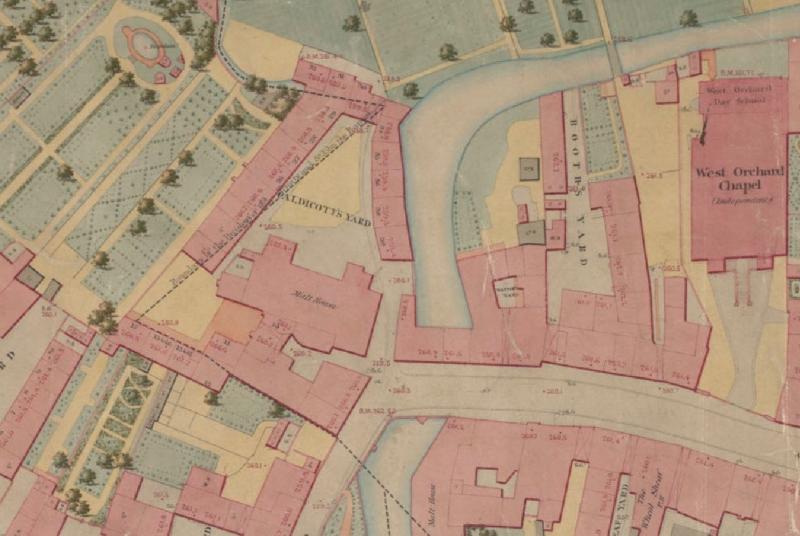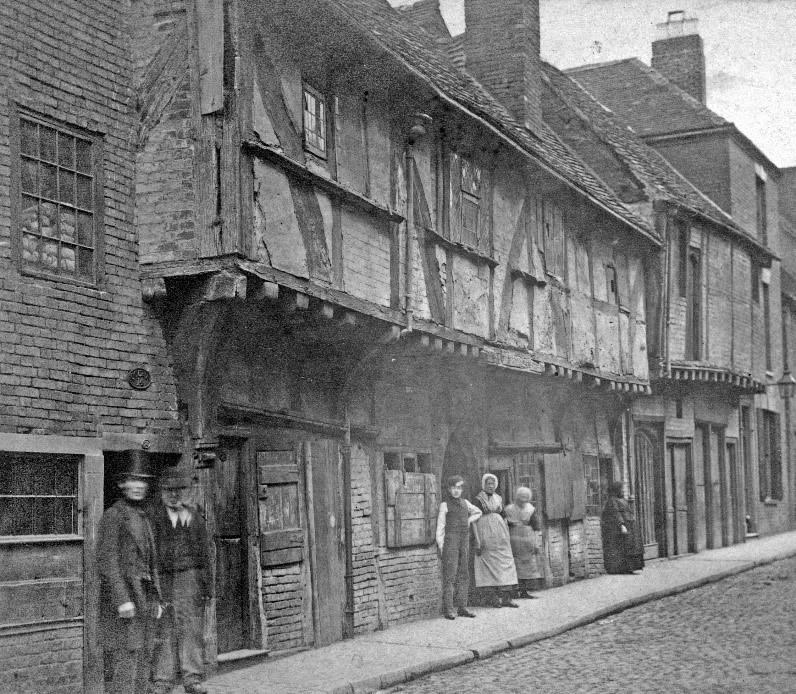CovArchives
Coventry
|
1 of 10
Wed 17th Jul 2019 2:02pm
In July 1849, Coventry established a local Board of Health and began to address the dismal situation of overcrowding, poor hygiene and disease that had become very much a part of everyday life in the city.
The new Boards had been created under the provisions of the Public Health Act of 1848 and one of its principal architects was Edwin Chadwick, who had also helped shape the provisions of the Poor Law some fifteen years earlier.
Chadwick believed that the best way to avoid the huge expense of providing relief for those who got sick was to improve the terrible circumstances in which they lived. He proposed that central government should take a much more active role in the provision of clean water and improved drainage; he also proposed that local councils be given the means by which to clear away refuse from homes and streets.
Coventry in the mid nineteenth century was a good example of Chadwick's argument: the city was dirty, overcrowded and prone to regular outbreaks of disease such as cholera. From the Black Death in the fourteenth century, to the Council's deliberations on how to "prevent the bringing of the plague and pestilence into this Citie" in the seventeenth (1), disease - despite all the attempts to combat it- was an inescapable part of life.
What exacerbated the problem in nineteenth century Coventry, however, was the rapid rise in the city's population. It grew by ten percent between 1838 and 1848, and although housing was being constructed, much of it was of poor quality. The Lammas and Michaelmas lands beyond the city's boundary could not be used for housing and private developers were building large numbers of houses in as small an area as possible to maximise the returns in rents; as a consequence, overcrowding and the problems associated with it became pressing issues.
William Ranger, appointed in 1849 to write a report on the state of the city's health (2) cites the example of a property in Caldicott's Yard (3) where he found "a man, wife, and five children, occupying a room twelve feet by six feet." This situation was by no means uncommon. With people crowded into such meagre living quarters, the rapid spread of disease was only to be expected.
But although the city had always been prone to outbreaks of scarlet fever and typhus, it was another epidemic of cholera that finally compelled Parliament to pass the 1848 Act. Opinion on what caused cholera varied from one medical authority to another, and so did the means by which to treat it. Those more inclined to trust in God rather than medicine could always turn to the "Special Prayer" recited at church services during cholera outbreaks, when the congregation would call upon the Lord Almighty for forgiveness: "thine unworthy servants... who turn to thee, their only refuge, in this season of sickness and great mortality" (4)
The City formed a Cholera Relief Committee in response to this fresh outbreak but a hundred people had died by the time it was properly up and running. The epidemic was eventually contained but it proved to be expensive: nearly four thousand people applied for relief and the cost of providing medicines, food, blankets, nurses, and gratuities paid to surgeons, came to nearly six hundred pounds.
The local Boards established at the end of 1840s were not without their limitations, but they did prove to be important first step in the safeguarding of public health. And more legislation was to follow, heralding further improvements. At Coventry Archives, the evidence of some of this early work has been preserved: one of the more remarkable artefacts is the Coventry Board of Health map, prepared by the Ordnance Department. A detail from it, showing Caldicott Yard as well as an image of alms houses at West Orchard, accompanies this post.
References:
1) Council Minute Book, 1635 - 1696, reference BA/H/3/17/2, Coventry Archives;
2) William Ranger, Superintending Inspector of the General Board of Health: "Report to the Public Body of Health on the City of Coventry," 1849, reference 352.4, "Green Box" C2c Public Health, Coventry Archives;
3) Taken to be the Caldicott's Yard at West Orchard, although there was another yard with the same name at Greyfriar's Lane. The image is taken from the Coventry Board of Health Map, reference SLA/2/4/3/16, Coventry Archives;
4) Pamphlet, "Cholera: Special Form of Prayer," reference JN 614.49, Coventry Archives
Board of Health Map 1851

Almshouses at West Orchard
 |
|
Local History and Heritage -
Coventry's seasons of sickness
|
NeilsYard
Coventry
|
2 of 10
Wed 17th Jul 2019 2:06pm
Thanks for the info - we've referenced the Board of Health Maps on here many times before, an invaluable asset.
|
|
Local History and Heritage -
Coventry's seasons of sickness
|
Helen F
Warrington
|
3 of 10
Wed 17th Jul 2019 3:35pm
Thanks for this Victoria 
Below shows two pictures of the entrance to Caldicott Yard with my rough mock up of the buildings, placed on a digital copy of that bit of the Board of Health map. The maps are a true work of art. The top row looks west with the yard entrance to the right. That picture is by William Henry Brooke. The second row looks north with the yard in the gap to the left of centre. The picture is Anne's copy of a Troughton drawing.

It's hard to imagine the city before the overcrowding and the industrialisation that followed. It was positively village like by modern standards. Most houses had substantial gardens and took up a decent sized stretch of road. There were orchards and even farming within the city walls. At times of the plague some houses were even left empty for want of new lodgers and were ordered to be demolished if they became derelict. By the time the maps were drawn, many of the gardens had been filled with strips of tiny yard homes and the bigger gardens were being cleared for factories.
The most northerly point of Caldicott's Yard had a small mill that was powered by a spur of the Radford Brook. I suspect that it could only have run when Naul's mill was releasing water to power its own equipment.
|
|
Local History and Heritage -
Coventry's seasons of sickness
|
Prof
Gloucester
|
4 of 10
Wed 17th Jul 2019 3:55pm
Very many thanks Victoria, this is superb. The people in the photo might even be ancestors of mine. They were Irish and the first wife of my 2x great grandfather was living in West Orchard when she died. First (or second) wife Mary Ann FLOOD (b Dublin 1799), died 19 Sept 1849 at West Orchard, Coventry of Asiatic Cholera. Buried 21 Sept 1849 aged 50, London Road Cemetery.
|
|
Local History and Heritage -
Coventry's seasons of sickness
|
NeilsYard
Coventry
|
5 of 10
Wed 17th Jul 2019 3:59pm
Would have been an early internment into LRC then Prof. IIRC (Derek will be able to confirm!) the first burials when the cemetery opened were in 1848.
|
|
Local History and Heritage -
Coventry's seasons of sickness
|
Prof
Gloucester
|
6 of 10
Wed 17th Jul 2019 4:34pm
Yes, thanks Neil, I do have details of the unmarked grave. My great-grandmother was buried with her parents and other members of their family on 14th Feb 1931, Coventry Cemetery RC burial plot sq 116 grave 90.
|
|
Local History and Heritage -
Coventry's seasons of sickness
|
Helen F
Warrington
|
7 of 10
Wed 17th Jul 2019 4:45pm
The photo is of the alms houses on the north side of the road, just east of the entrance to the market (the south side of the road). The doorway to the left went to HAND'S YARD.
|
|
Local History and Heritage -
Coventry's seasons of sickness
|
Helen F
Warrington
|
8 of 10
Thu 18th Jul 2019 9:29am
Yes, its after the market hall. Further to the east. These buildings were demolished to make way for the Lion Foundry/Matterson's. If the photo you posted had been looking a little more to the right you'd have been able to see Cross Cheaping. Swivel round to the right and the camera would have been able to see the stocks, the gaol and the old market building.
|
|
Local History and Heritage -
Coventry's seasons of sickness
|
Kaga simpson
Peacehaven, East Sussex
|
9 of 10
Thu 18th Jul 2019 12:01pm
But Coventry had long started cleaning up before 1848.
A very old house in Little Park Street, thought to be the Bakers Guild house, was pulled down early 1800's to make way for a vaccination station.
Now look at CovArchives photo, the street is as clean as any today. The fault lay elsewhere.
The Victorian era was one of great transformation in a great number of ways, but mainly from church to industry.
There has always been a pecking order in animals and humans, but the Victorians honed it and polished it. Labourers 3rd class, supervisors 2nd class, owners 1st class, and at the top the aristocrats.
It was not the state of the country or even the system.
About 1820 the magistrates (mainly church men) fixed the price a family should live on, 8/9 shillings a week, depending on number of children.
Now a pound loaf, and quarter lb of cheese came to 5d (old money), that's 3 shillings a week less a penny. And that was just a 'snap', not a real meal. So how was a labouring man, his wife and children to exist, find rent, bedding, food, clothing, fuel? So they had to labour on half-starvation.
At the same time, class-conscious merchant and bankers, fundholders and stock-jobbers were taking over and they took all the produce and left the labourer that had produced the goods half-starved workers - hence the Tollpuddle Martyrs of 1834.
|
|
Local History and Heritage -
Coventry's seasons of sickness
|
Helen F
Warrington
|
10 of 10
Thu 18th Jul 2019 1:24pm
From stuff I've read with debatable veracity -
1377 4817 adults, possibly 7226-9634 in total
1434 9824-10,000 population total (this may have been the peak until mid 1700s though it may have been a few thousand higher)
1479 3300 people died, possibly of cholera
1485 135 of 387 properties belonging to Trinity Guild are empty and it's likely the same was true for the rest of the city
1549 3000 people (taken from a letter from John Hales who states that population had been 15,000 within memory. Both figures may be exaggeration to create sympathy)
1586 there were 6502 men, women and kids
1603 494 died of plague
1642 9500 people in total - increase due to arrival of people seeking safety from the Civil War and soldiers
1694 6710 people in the city (a fall due to disease and temporary occupants returning home after the War)
1749 2065 houses Coventry, 12117 people
1801 2930 houses, 16049 people
There was little shortage of land and properties until at the earliest 1749 (the date of the Bradford Map) but disease from people, water, lack of cleanliness and decaying buildings had long been a problem. Keeping the streets clean was actually well planned for and there were numerous edicts to keep it that way. Disease in the early years was the result of ignorance, not a lack of trying. But after 1748 the population grew too big for the city to manage even knowing more about disease. The yards and courts held far more people than the facilities could cope with.
|
|
Local History and Heritage -
Coventry's seasons of sickness
|
 Almshouses at West Orchard
Almshouses at West Orchard
